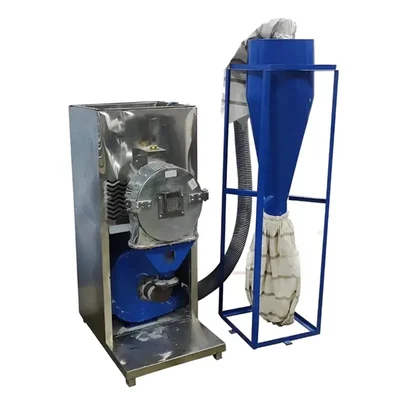- Farm & Garden
- Pumps & Motors
- Food Processing
- Workshop, DIY & MRO
- Lab & Measuring Tools

<
>
Brand: MILL POWER
Mill Power 7.5 HP Flour Mill/Pulverizer Machine with Blower, 80 Kg/hr Production Capacity
SKU: SD-MP-20232848
 612 people have viewed this recently
612 people have viewed this recently  Delivery By: Dec 25 - Dec 27
Delivery By: Dec 25 - Dec 27 




MRP : ₹215190

 612 people have viewed this recently
612 people have viewed this recently  Delivery By: Dec 25 - Dec 27
Delivery By: Dec 25 - Dec 27 
Easy Return
& Refund
& Refund

Quality
Assurance
Assurance

Trusted
Delivery
Delivery

After Sales
Assistance
Assistance

Buyer
Protection
Protection
₹215190 (Including GST)
Get Extra ₹3,228 OFF on Prepaid Orders
QTY :
-
1
+
Short Description
Mill Power 7.5 HP Flour Mill/Pulverizer Machine with Blower
Output Capacity 80 Kg/hr
Body Material Stainless Steel
Country of origin: India
Specifications
- Brand: MILL POWER
- Material : Stainless Steel
- Weight (Approx.) : 200 kg
- Model No. : SSH7.5DB
- Motor Power : 7.5 HP
- Phase : Three
- Watt : 3700 W
- Voltage : 460 V
- Output Capacity : 80 Kg/hr
- Power Consumption : 5 Kwh
- Jali : 8 nos.
- Chamber Size : Small (8x4 inch) / (20.32 x 10.16 cm) and Big (5x11 inch) / (12.7 x 27.94 cm)
Description
The 2 in 1 Flour Mill/Pulverizer is one type of grinding equipment that is utilized in several sectors, especially the food processing sector. The machine's design prioritizes stability, low energy usage, and efficiency. It can be used to grind a variety of commodities, such as wheat, rice, and corn. Because of its straightforward design, low maintenance needs, and convenience of operation, the pulverizer is ideal for use in the food processing industry. The machine has a 7.5 HP three phase motor to function, along with that the machine has a production capacity of 80 kilograms per hour making it a perfect fit for commercial usage.
Features
:- Efficient Grinding Mechanism: The pulverizer utilizes a powerful grinding mechanism that ensures uniform particle size reduction, enhancing the quality of the final product
- Enhanced Versatility: Pulverizers with blowers can handle materials like grains and spices making them suitable for various food processing scenarios.
- User-Friendly Operation: Pulverizer is equipped with intuitive controls and user-friendly interface, allowing operators to adjust settings with ease to achieve desired particle sizes.
Accessories
:- Digital Starter with MCB Switch, Cleaning Brush, Flour Container, Masala Hopper, Micro Fine Cloth, 8 Seives (Jali), Door Cover, Anti Vibration Knobs, Cable Wire.
Applications
:- Grinding of Grains: The pulverizer effectively grinds various grains such as wheat, rice, and corn into flour, facilitating seamless production of baked goods and other grain-based products.
- Spice Processing: The precise grinding capabilities allow for the production of fine spice powders, ensuring uniform texture and enhanced flavor profiles in culinary preparations.
- Custom Formulation of Food Ingredients: Food manufacturers can utilize the pulverizer to create custom formulations, tailoring products to specific dietary needs, such as gluten-free or low-calorie options.
Usage
:1. Understanding the Components :
Before operating the pulverizer, it is essential to understand its main components:
- Pulverizer: This is the primary machine that grinds materials into fine powder.
- Blower: The blower is used to transport the pulverized material from the grinding chamber to the collection system or bagging unit.
2. Setting Up the Equipment :
- Location: Ensure that both the pulverizer and blower are set up in a stable location with adequate space for operation and maintenance.
- Electrical Connections: Check that all electrical connections are secure and comply with safety standards. The machine should be connected to an appropriate power supply.
- Air Supply for Blower: Ensure that the blower has a sufficient air supply for optimal performance.
3. Preparing Raw Materials :
- Material Selection: Choose materials suitable for pulverization, such as grains, spices, or other dry substances.
- Pre-processing: If necessary, pre-process materials by removing moisture or large particles that could clog the system.
4. Operating the Pulverizer :
- Start-Up Procedure: Turn on the power supply to both the pulverizer and blower. Allow both machines to reach their operational speeds before introducing any material.
- Feeding Material: Gradually feed raw materials into the pulverizer using a controlled feeding mechanism. Avoid overloading, as this can lead to inefficient grinding or damage.
- Monitoring Performance: Observe the grinding process.. Ensure that there are no unusual noises or vibrations indicating potential issues.
5. Utilizing the Blower :
- Transporting Powdered Material: Once material is ground, it will be transported via airflow created by the blower. Adjust blower speed settings if necessary to optimize material flow.
- Collection System Setup: Ensure that collection bags or containers are securely attached at discharge points to prevent spillage of powdered material.
Maintenance :
- Regular Cleaning: After each use, clean the pulverizer thoroughly. Use a soft brush or cloth to remove flour dust from all accessible surfaces.
- Sharpening Blades: Depending on usage frequency, sharpen the grinding blades regularly to maintain efficiency in milling. Dull blades can lead to increased strain on the motor and reduced output quality.
- Checking the Blower: Inspect the blower for any damage or holes that could affect its performance. Ensure all bolts on the blower are secure.
- Cleaning Dust Accumulation: Remove dust from inside the blower and surrounding areas to prevent blockages that can hinder airflow.

Select attribute












